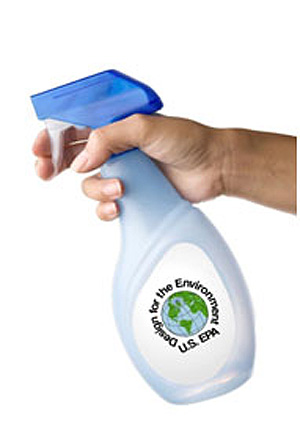Indoor Chemical Exposure: Novel Research for the 21st Century
By Meridith M. Fry, Ph.D.
While it is widely known that nearly every consumer product contains chemicals, have you ever wondered what chemicals lurk inside your home or office building? Semivolatile organic compounds (SVOCs) are chemicals found indoors in the air and on surfaces that come from cleaning products, personal care products, pesticides, furnishings, and electronics. They are released slowly into the air and can attach to surfaces or airborne particles, allowing them to enter the body by inhalation, ingestion, or absorption through the skin. Because SVOCs can persist indoors for weeks to years, they also may contribute to prolonged human exposure. In fact, individuals in the US have measureable levels of more than 100 SVOCs in their body at any given time.
 The health effects from exposure to SVOCs vary depending on the particular SVOC, the length of exposure, and personal susceptibility. SVOCs have been associated with allergies, asthma, endocrine and thyroid disruption, reproductive toxicity, and fetal and child development delays. Given the significance of these health effects, we’re funding research to learn more about SVOC exposure and how we can reduce it.
The health effects from exposure to SVOCs vary depending on the particular SVOC, the length of exposure, and personal susceptibility. SVOCs have been associated with allergies, asthma, endocrine and thyroid disruption, reproductive toxicity, and fetal and child development delays. Given the significance of these health effects, we’re funding research to learn more about SVOC exposure and how we can reduce it.
Through our Science to Achieve Results (STAR) Grants for New Methods in 21st Century Exposure Science, researchers from Virginia Polytechnic Institute and State University and the University of Michigan are making great strides in developing new methods for measuring indoor exposure to SVOCs:
- A new, simple method has been developed by researchers from the Virginia Polytechnic Institute and State University to determine vapor pressure, an important yet uncertain chemical property of SVOCs. Vapor pressure is a measure of the tendency of these chemicals to escape (from a liquid or solid) into the air. With better vapor pressure estimates, our understanding of how SVOCs move indoors will greatly improve.
- Researchers from the University of Michigan are also developing a novel, portable device to rapidly measure hundreds of SVOCs indoors. This research has already spurred applications for three new patents and resulted in four peer-reviewed publications. Milestones include the development of a micro-photoionization detector (PID) to identify which chemicals are present in the air, a miniaturized helium discharge PID that also offers rapid measurement, low power consumption, and a fast warm-up time, and an automated, portable gas chromatography system to measure chemicals in water. These new instruments can be easily carried in the field and used on-site, revolutionizing current measurement technology which tends to be bulky and non-portable.
The research and findings from these STAR grants will continue to shape exposure science in the 21st Century, and increase our knowledge about SVOCs and how they affect our everyday lives. STAR grantees from the University of California Davis, Duke University, and University of California San Francisco also are making substantial contributions to our understanding of SVOC exposure such as developing new methods to measure SVOCs in indoor dust, exposures in children, and exposures in pregnant women. We are eager to continue sharing these groundbreaking achievements as they become available.
References:
Weschler, C.J. and W.W. Nazaroff, Semivolatile organic compounds in indoor environments. Atmospheric Environment, 2008. 42(40): p. 9018-9040.
Xu, Y. and J. Zhang, Understanding SVOCs. ASHRAE Journal, 2011. 53(12): p. 121-125.
Lawrence Berkeley National Laboratory Indoor Environment Group, SVOCs and Health, 2016. Available: https://iaqscience.lbl.gov/voc-svocs
About the Author: Meridith Fry is an Environmental Engineer and Project Officer in EPA’s National Center for Environmental Research, Chemical Safety for Sustainability Research Program.



